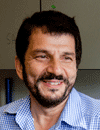Co-Located Conference Agendas3D-Bioprinting 2021 | Innovations in Microfluidics & SCA 2021 | 

Thursday, 18 March 202108:00 | Conference Registration, Materials Pick-Up, Morning Coffee and Pastries | |
Session Title: Innovations in Microfluidics 2021 Conference Opening Session |
| | 09:00 |  | Keynote Presentation Selection of Single Cells by Function Using Lab on a Particle Technology
Dino Di Carlo, Armond and Elena Hairapetian Chair in Engineering and Medicine, Professor and Vice Chair of Bioengineering, University of California-Los Angeles, United States of America
The ability to create picoliter and nanoliter compartments using microfluidics has driven biotechnology at its ultimate "quantum limit" of single cells and molecules. I will discuss the progress we have made in developing assays for cell secretion and growth, leveraging particles to impart new features on compartments, such as ease of use or compatibility with production environments. I will discuss applications ranging from microalgal culture and clone selection to workflows for selecting antibody-secreting cells using standard fluorescence activated cell sorters. Lab on a particle technology promises to expand the capabilities and the accessibility of quantum biological assays. |
| 09:30 |  | Keynote Presentation D3 PCR: Ultra-Sensitive Detection with Drop Microfluidics
David Weitz, Mallinckrodt Professor of Physics and Applied Physics, Director of the Materials Research Science and Engineering Center, Harvard University, United States of America
This talk will describe a method for very sensitive detection using drop-based microfluidics to perform PCR. To increase sensitivity and specificity, a second round of detection is used to read the contents of the drops with amplified targets. This method can be applied to several different detection applications. |
| 10:00 | Diffusion-based Separation Using Bidirectional Electroosmotic Flow
Moran Bercovici, Associate Professor, Faculty of Mechanical Engineering; Head, Technion Microfluidic Technologies Laboratory, Technion, Israel Institute of Technology, Israel
We present a microscale separation method that leverages bidirectional flow, generated by an array of alternate-current field-effect electrodes, to electroosmotically tune the dispersion regime of molecules and particles. Under bidirectional flow the relative motion of species due to differences in their molecular diffusivity can be significantly enhanced. The system can be configured so that low diffusivity species experience a ballistic transport regime and are advected through the chamber, whereas high diffusivity species experience a diffusion dominated regime with zero average velocity and are retained in the chamber. We experimentally demonstrate the separation of particles, antibodies, and dyes, and present a theoretical analysis of the system, providing engineering guidelines for its optimal design and operation. This method provides means for leveraging molecular diffusivity for analysis and sample preparation applications, particularly for sub-microliter sample volumes that are not compatible with standard separation techniques. | 10:30 | Morning Coffee Break and Networking | 11:00 |  Customizing Single Cell Research Customizing Single Cell Research
Thomas Ayers, Sr. Technical Applications Specialist, Dolomite Bio
Here we report a flexible and cost-effective droplet-based microfluidics system, called the Nadia Instrument, that can allow 3’ mRNA capture of ~50,000 single cells or individual nuclei in a single run. The precise pressure-based system demonstrates highly reproducible droplet size, low doublet rates and high mRNA capture efficiencies that compare favourably in the field. Moreover, when combined with the Nadia Innovate, the system can be transformed into an adaptable setup that enables use of different buffers and barcoded bead configurations to facilitate diverse applications. We demonstrate how this robust and versatile system unlocks high throughput single cell profiling for large plant leaf protoplasts and single cells or nuclei with poor RNA yields. With the Nadia Innovate, we present a solution for diverse sample types, whilst allowing researchers to complete more single cell transcriptomic projects within budget.
| 11:30 |  | Keynote Presentation “More is More”: Precision Microfluidics of Cells in Large Bodily Fluids
Mehmet Toner, Helen Andrus Benedict Professor of Biomedical Engineering, Massachusetts General Hospital (MGH), Harvard Medical School, and Harvard-MIT Division of Health Sciences and Technology, United States of America
The ability to process ‘real world-sized’ volumes has been a major drive in the field of microfluidics. This begs the question whether it is possible to take advantage of microfluidic precision without the limitation on throughput required for large-volume processing. The challenge is further compounded by the fact that physiological fluids are non-Newtonian, heterogeneous, and contain viscoelastic living cells. We are motivated by a broad range of applications enabled by precise manipulation of extremely large-volumes of complex fluids, especially those containing living cells or bioparticles. This presentation will provide a summary of our efforts in bringing microfluidics to large volumes and complex fluids as well as various applications such as the isolation of extremely rare circulating tumor cells from whole blood. |
| 12:00 |  | Keynote Presentation Soft Microfluidic Systems for Human Skin
John Rogers, Simpson/Querrey Professor of Materials Science and Engineering, Northwestern University, United States of America
Recent advances in materials, mechanics and manufacturing establish the foundations for high performance classes of microfluidic lab-on-a-chip technologies that have physical properties matched those of the human skin. The resulting devices can integrate with the surface of the skin in a water-tight yet physically imperceptible fashion, to provide continuous, clinical-quality biochemical information on physiological status via capture, storage and in situ analysis of sweat. This talk summarizes the key ideas and presents specific recent examples in skin-interfaced microfluidic technologies designed for applications in sports performance, worker safety and nutritional monitoring. |
| 12:30 | Networking Lunch in the Exhibit Hall for the Physical On-Site Participants | 13:00 |  YAMAHA CELL HANDLER: Automated, Rapid Spheroid, Organoid and Single Cell Sort System by Imaging and Picking YAMAHA CELL HANDLER: Automated, Rapid Spheroid, Organoid and Single Cell Sort System by Imaging and Picking
Yuichi Hikichi, General Manager, MDB Division , Yamaha Motor
By using various parameters of images, like size, shape and fluorescent intensity, the CELL HANDLERTM can automatically select single cells or 3D spheroids and sort them to various types of culture plates. It uses a unique disposable tip to ensure the damage-free and accurate handling and enables direct picking of organoids from gel. Conventional manual methods have been hampered by low throughput and suboptimal accuracy. Conventional cell sorters damage cells and need significant amounts of cells and are not applicable for spheroids and organoids. The CELL HANDLER complements these deficiencies. It enables more accurate and higher throughput sorting than manual operation and low amounts of cells (e.g. 100-1000 cells) can be sorted without damages. Any types of plates (e.g. microtiter plates, micro cavity plates, 3D colony in gel, 2D colony on plate, organ-on-a-chip) can be used as a source plate and destination plate, which will support many types of applications. The CELL HANDLER is a high-speed, high-precision pick and place system coupled with image capture and analysis capability that greatly increases the efficiency and reliability of spheroid/organoid and single cell assays.
| 13:30 | A Systematic Comparison of Single Cell RNA-Seq Methods
Joshua Levin, Senior Group Leader, Research Scientist, Stanley Center for Psychiatric Research, Klarman Cell Observatory, The Broad Institute of MIT and Harvard, United States of America
A multitude of single-cell RNA sequencing methods have been developed in recent years, with dramatic advances in scale and power, and enabling major discoveries and large scale cell mapping efforts. We directly compared seven methods for single cell and/or single nucleus profiling from three types of samples – cell lines, peripheral blood mononuclear cells and brain tissue. To analyze these datasets, we developed and applied scumi, a flexible computational pipeline that can be used for any scRNA-seq method. We evaluated the methods for both basic performance and for their ability to recover known biological information in the samples. | 14:00 |  | Keynote Presentation Affinity Selection and Enumeration of SARS-CoV-2 Viral Particles from Saliva Samples using Microfluidics for COVID-19 Diagnostics
Steve Soper, Foundation Distinguished Professor, Director, Center of BioModular Multi-Scale System for Precision Medicine, The University of Kansas, United States of America
Coronavirus disease 2019 (COVID-19) arises from the SARS-CoV-2 virus and has been found to be highly contagious. To mitigate spreading, testing has been deemed an important asset. Testing has predominately utilized RT-qPCR as well as serological-based tests. However, while new machines are rolling out for point-of-care testing (POCT), issues are present with these common testing systems, for example the need for reagents (e.g. enzymes, fluorescent reporters, antibodies), workflows that sometimes require specialized operators, and the inability to distinguish between infectious and non-infectious individuals, which is important in determining the need for quarantining. We report an innovative COVID-19 diagnostic test that directly addresses the aforementioned issues. The assay accepts a clinical sample and specifically selects SARS-CoV-2 particles from the sample using surface-immobilized DNA aptamers targeting the spike protein, releases photolytically the selected viral particles (VPs), and then counts the number of SARS-CoV-2 particles using a label-free approach. The workflow is simple and fully automated and also, no reagents are required once the assay is deployed for testing. The entire assay was carried out using microfluidic chips made from a plastic that were injection molded to allow for high scale production at low cost. The VP selection chip consisted of 1.5 million pillars that allowed for affinity loading up to 1010 SARS-CoV-2 particles at a recovery ~90%. Following selection, the VPs were released from the capture surface using a photocleavable linker by a blue-light LED (79% release efficiency) and subsequently counted using a nano-Coulter Counter (nCC). For high throughput single VP counting, 5 nCCs were placed in parallel and offered 100% detection efficiency for VPs travelling through a 200 nm pore. The entire assay could be completed in <20 min. In a 20 patient blinded study, the test correctly identified 10 non-infected individuals (clinical specificity = 100%) and in 5 COVID-19 patients, VPs were detected indicative of “active” disease, while 4/5 others were deemed infected by RT-qPCR, but those individuals had no VPs suggesting these patients were not contagious (clinical sensitivity = 95%). |
| 14:30 |  Single-Button Nucleic Acid Extraction for Rapid, Reliable Molecular Testing Single-Button Nucleic Acid Extraction for Rapid, Reliable Molecular Testing
Richard Chasen Spero, CEO, Redbud Labs
There are myriad exciting microfluidic platforms for molecular analysis, but few are designed to work with raw samples. We describe a new initiative at Redbud Labs to enable single-button sample preparation on a microfluidic cartridge, focusing on nucleic acid extraction for amplification and sequencing applications. Our method combines gold-standard laboratory biochemistry with cartridge-ready™ chips, MXR™DryPak and STR™BeadPak, to deliver lab-quality yield, fast runtimes, and compact design. We will also share strategies employed to develop our platform on a highly compressed timeline.
| 15:00 |  | Keynote Presentation Microfluidic Tools For Monitoring the Immune System
Joel Voldman, Clarence J. Lebel Professor of Electrical Engineering, Massachusetts Institute of Technology, United States of America
Microsystems have the potential to impact biology by providing new ways to manipulate, separate, and otherwise interrogate cells. Immune cells are of particular interest because of their central role in defending the body against foreign invaders. As a consequence, many microfluidic devices have been used to study both the basic biology of immune cells as well as to assay them for clinical use. Our lab has developed technologies on both ends of the spectrum, from cell pairing devices able to study information flow in immune cells, to electrical sorting devices for assaying immune cell function in response to disease. In terms of cell pairing, we have developed two complementary approaches to creating programmed pairs of cells, one using capture “cups” and a three-step back-and-forth loading procedure to pair thousands of cells in parallel, and the other using microfluidic “corrals” to contain cells. With these devices we can pair immune cells with each other or with other cells (i.e., tumor cells) to study information flow from first contact to downstream effector functions, elucidating how decision-making occurs in these interactions. |
| 15:30 | Afternoon Break | 16:00 | Microfluidics’ New Wave: Digitally-Fabricated Microdevices
Albert Folch, Professor of Bioengineering, University of Washington, United States of America
The vast majority of microfluidic devices are presently manufactured using micromolding processes that work very well for a reduced set of biocompatible materials, but the time, cost, and design constraints of micromolding hinder the commercialization of many devices. PDMS, in particular, is extremely popular in academic labs, yet the fabrication procedures are based on cumbersome manual methods and the material itself strongly absorbs lipophilic drugs. As a result, the dissemination of many cell-based microfluidic chips – and their impact on society – is in jeopardy. Digital Manufacturing (DM) is a family of computer-centered processes that integrate digital 3D designs, automated (additive or subtractive) fabrication, and device testing in order to increase fabrication efficiency. Importantly, DM enables the inexpensive realization of 3D designs that are impossible or very difficult to mold. The adoption of DM by microfluidic engineers has been slow, likely due to concerns over the resolution of the printers and the biocompatibility of the resins. We have developed microfluidic devices by SL in PEG-DA-based resins with automation and biocompatibility ratings similar to those made with PDMS. The resins allow for building transparent microchannels, microvalves, and multi-material devices containing hydrogels of larger-MW PEG-DA formulations. | 16:30 |  The Simultaneous Determination of Biomolecules Binding Affinities On Multiple Varied Immobilization Surfaces The Simultaneous Determination of Biomolecules Binding Affinities On Multiple Varied Immobilization Surfaces
Claude Dufresne, CEO, axiVEND LLC
In many microfluidics devices, biomolecules are captured by pre-deposited proteins in channels, reaction chambers, or on microarrays. The correct immobilization of these proteins is critical to obtain the best device performance. While many polymeric materials exist for protein immobilization, it is often quite tedious to go through a selection process. Beyond binding capacity as a classic factor, often the orientation and functional ligand activity are more important.
This talk will present a method by which multiple polymers can be evaluated in parallel, in the same experiment. Dozens of candidate surface binding polymeric materials are spotted on a Si/SiO2 chip, followed by spot-on-spot protein functionalization. Target protein capture is then observed by interferometric reflectance. This allows for binding curves to be generated for each protein/surface polymer pair, in parallel, and under the same conditions. The results are invaluable in assessing various polymeric formulations for optimal presentation of the capture molecule and its ensuing target molecule binding properties.
Since the underlying device material is covered with the binding polymer, the method described is applicable to a wide range of applications.
| 17:00 | Highly Multiplexed Diagnostics with Droplet Microfluidics Enhanced by Compressed Sensing
Pavan Kota, Ph.D. Student, Dept of Bioengineering, Rice University, United States of America
Microfluidics can generate thousands of droplets to capture individual analytes, but usually only a few measurements can be acquired from each droplet at high throughput. Multiplexing efficiently with limited sensors is possible through compressed sensing if samples are sparse; most possible analytes must be absent from any particular sample. The authors recently developed a new compressed sensing algorithm called Sparse Poisson Recovery (SPoRe) that further exploits the Poisson statistics of microfluidic capture. Given an application-driven measurement model, SPoRe efficiently solves a maximum likelihood estimation problem to recover total analyte abundances. This work presents the first in vitro demonstration of SPoRe towards bacterial infection diagnostics with 16S droplet digital PCR (ddPCR). Five nonspecific probes assign binary barcodes to nine bacterial genera. Each droplet measurement is modeled as an OR operation among the present 16S genes’ barcodes. Although a single droplet’s contents may be ambiguous under this model, SPoRe solves for bacterial abundances by considering all droplets simultaneously. Moreover, SPoRe can pool data from multiple reactions with different subsets of probes to address limitations caused by probe cross-reactivity and fluorescence spectral overlap. SPoRe raises new possibilities in ddPCR-based diagnostics, and its modularity for nearly any measurement model enables applications beyond digital sensing.
| 17:30 | Rapid Pre-Concentration for Salivary Measurement of Respiratory Viruses such as Influenza and COVID
Amy Drexelius, PhD Candidate, University of Cincinnati, United States of America
If there were a simple and passive technique, that would downshift the range of detection of all your sensors and analytes by 10-100X, what value would you place on such a breakthrough? Presented are single step and fast membrane pre-concentration devices for applications ranging from continuous wearable biosensing (sweat, interstitial fluid) to point of care diagnostics (blood, urine, saliva), which can detect analytes present in respiratory viruses such as influenza and COVID-19. These devices now show >10X preconcentration in minutes for analytes ranging from small molecules (e.g. cortisol) to large proteins (influenza). Further demonstrated are techniques that allow rapid adaptation of the devices for a wide variety of sensing modalities, including those sensitive to changes in pH or salinity. | 18:00 | Characterization and Modeling of Paper-based Bi-Material Actuator Cantilever; Application in Phosphate Detection
Amer Charbaji, Researcher, University of Rhode Island, United States of America
Paper-based microfluidics provide a simple, inexpensive, and user friendly approach for a variety of applications, such as environmental monitoring, healthcare, food safety, and various other miscellaneous purposes. Paper-based devices are made up of several different sections and, depending on the application, may require the use of an actuator for proper control of flow time, reaction time, sample volume or the sequential loading of reagents. In our previous publication, we described a novel autonomously-activated bi-material actuator cantilever (B-MAC) that offers several unique advantages for use in paper-based microfluidic devices. The B-MAC allows for the autonomous operation of paper-based devices that require sequential and timed delivery of multiple reagents. It is also simple to fabricate, requires small sample volumes to operate, and has a quick response time. The B-MAC is made up of a strip of filter paper that is partially laminated on one side with tape. Once the filter paper side is exposed to a fluid, the cellulose fibers experience hygro-expansion, whereas the adjoining tape layer remains constant in length. This difference in the expansion behavior of the paper and tape cause the cantilever to bend in the direction of the tape layer as shown below and touch the stationary component (SC). The B-MAC has been shown to be applicable to 1D, 2D, and 3D lateral flow devices. In this study, the B-MAC will be assessed as a potential actuator to be used in a paper-based device for the sensitive detection of phosphate in water. The most commonly used method to determine soluble phosphate in water is based on the molybdenum blue reaction. This assay has been implemented on paper-based devices before and requires multi-step loading of reagents to improve sensitivity, shelf life, and to reduce auto-reduction of the reagents. Using B-MAC in a paper-based device for phosphate detection will allow the sequential loading of multiple reagents to perform the molybdenum blue assay to detect phosphate with minimal human intervention other than simply adding the sample fluid. | 18:30 |  | Keynote Presentation Microfluidics Technology Development For Liquid Biopsy
Shannon Stott, Assistant Professor, Massachusetts General Hospital & Harvard Medical School, United States of America
This talk will outline the steps taken for technology development and validation for the microfluidic devices developed in our laboratory. I will share data from our effort to develop a blood test for brain tumors, with a focus on signatures obtained from circulating tumor cells and extracellular vesicles. |
| 19:00 | Close of Day 1 of the Conference |
Friday, 19 March 2021 |
Please View Details of Day 2 of the Event Under the 3D-Bioprinting Track Agenda Section |
| |
|


 Add to Calendar ▼2021-03-18 00:00:002021-03-19 00:00:00Europe/LondonInnovations in Microfluidics and SCA 2021Innovations in Microfluidics and SCA 2021 in BostonBostonSELECTBIOenquiries@selectbiosciences.com
Add to Calendar ▼2021-03-18 00:00:002021-03-19 00:00:00Europe/LondonInnovations in Microfluidics and SCA 2021Innovations in Microfluidics and SCA 2021 in BostonBostonSELECTBIOenquiries@selectbiosciences.com